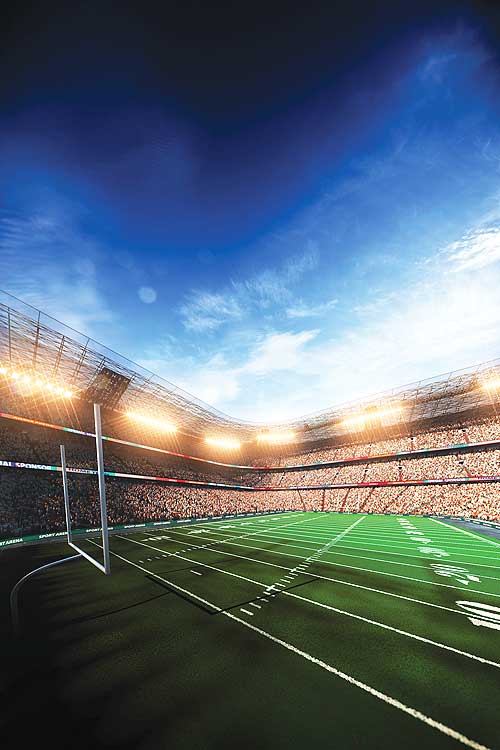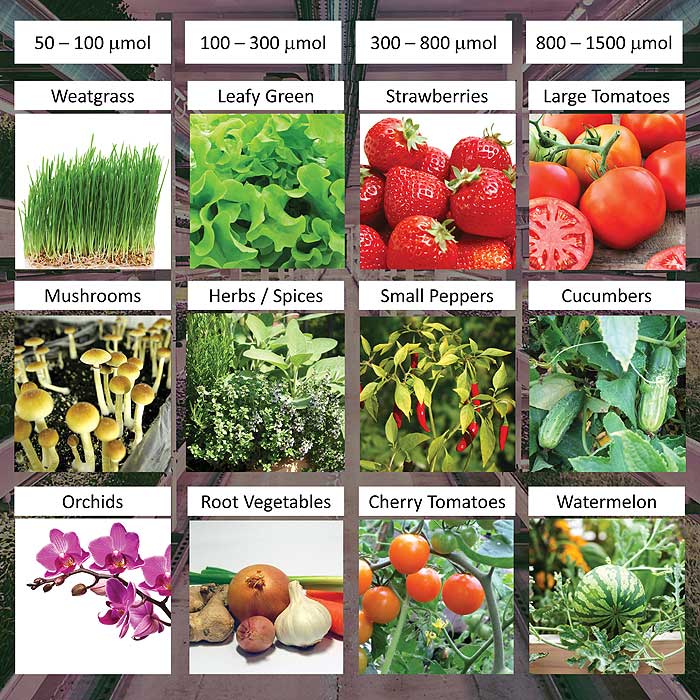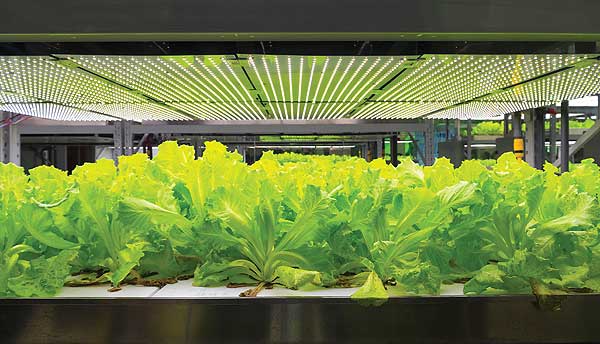Could lighting contribute to feed 10 billion people in 2050?

Figure 1: Stadium Solid State Lighting saving more than 60% energy compared to conventional lighting (source PRBX / iStock)
With the vital need to save energy, the power industry has permanently innovated numerous ways to increase efficiency including by the way we convert electron to electron. Power conversion ratios are approaching physical limits, energizing researches and inventions and enabling applications that were heretofore impossible or at least not cost effectively viable. In lighting, new applications are requiring power designers to explore a new dimension, the efficient conversion from electron to photon which has created the lighting of the future.
Since 1860, when the English inventor Sir Joseph Wilson Swan created the first electric light bulb concept, followed by Thomas Edison and his team in 1879 patenting and perfecting the carbon-thread incandescent lamp after many, many attempts and the subsequent and rather ubiquitous “Edison bulb” used around the world, the lighting industry has been continually evolving. From the sodium lamps introduced by Philips in 1932 and the commercialization of the fluorescent lamps by General Electrics in 1938, to the introduction of “energy saving in lighting” this segment has been very innovative but as well contributed to the development of vital technologies in health, safety and sustainability.
The amazing flood of lighting innovations, contributed to make our lives better while reducing energy consumption but the real benefits are not always obvious when applying on very large scale.
From: “how to save three quarter of the energy consumed to light gigantic stadiums to how to grow food for, projected, 10 billion people in 2050”, energy efficient and intelligent lighting are taking part of the solution! How could that be possible?
Solid State Lighting on stadium and many more!
The lighting market segment is very diversified, but Solid State Lighting (SSL) based on LEDs have popped the conventional light bubble making the Edison bulb effectively obsolete and they are now infringing on fluorescent lighting. as well. The possibilities offered by SSL are also bringing lighting advantages in industrial applications such as for roads and parking lots, stadiums and stages (Figure 1), but as well for urban farming, horticulture, water purification, and medical lighting and light therapy.
Where electrons meet photons, it requires power designers to work very close with LED manufacturers. One example is so-called “GaN (Gallium Nitride) lighting,” using GaN transistors in the power stage, and GaN-on-Silicon in the LED element. Although anecdotic, it reflects the industrial maturity of the usage of GaN in the power and lighting industries. As power designer it is very interesting to follow both technologies and I foresee huge benefits in that association.
SSL lighting currently dominates some segments of the lighting market where the cost of replacing a light bulb is inordinately expensive and could cost the end user more than the light itself. Lights on tall poles where a lift truck is required to even reach the lighting fixture would be an example. Having to stop or reroute traffic on a bridge or in a tunnel is another example. These type of applications benefit from having very long lasting SSLs Additionally, the SSLs are much more efficient than the typical high pressure light that they are replacing so the power consumption for providing the same level of light is notably reduced, often resulting in a very good ROI for the end user but also high contribution to reduce energy consumption.
One example is the Houston’s NRG Stadium (USA), which in 2015 became one of the first professional venues to use energy-efficient LED lights. The field was illuminated exclusively by 65.000 LED light consuming, when at full power, 337 kilowatts! Seems to be a lot of power though it is about 60 percent less energy than the previous system using conventional stadium-lighting and we foresee future technologies to save even more energy with 75% saving in target. The energy saved is remarkable but only the beginning of what is possible when combining SSL technology and efficient power management. More large infrastructures and cities are renovating their lighting systems in favour of digitally controlled SSL and, combined with renewable energy, we are approaching the mythic zero emissions lighting circle (from generation to utilisation).
Lighting for food to all!
Right now, there are around 7.6 billion people in the world and every year, the world’s population is expanding by 83 million people. By 2050, there will be just short of 10 billion. Providing food to 10 billion people will require the agriculture to develop very efficient production processes while preserving the environment by reducing hazardous chemical and optimizing water utilisation.

Figure 3: The Photosynthetic Photon Flux Density required to grow plants and vegetables typically starts at 450 nm (blue light) and goes through 730 nm (far red) (source PRBX)

Figure 4: Light energy required ranges from 50 micromoles (µmol) for mushrooms up to 2.000 µmol for light intensive plants (source PRBX)
In a recent communication, the World Bank very well pictured the situation and what was the expected future of food supply around the world. “The world needs to produce at least 50 percent more food to feed 10 billion people by 2050. But climate change could cut crop yields by more than 25 percent. The land, biodiversity, oceans, forests, and other forms of natural capital are being depleted at unprecedented rates. Unless we change how we grow our food and manage our natural capital, food security – especially for the world’s poorest – will be at risk.”
Considering all the parameters and requirement to produce food with the highest respect for the environment, in 1999, Dr. Dickson Despommier with his students developed the idea of a modern indoor farming, revitalizing the terms coined in 1915 by the American geologist Gilbert Ellis Bailey: “Vertical farming.” We have all heard about it, read a lot of articles about industrial building converted into vertical farms but from the early days using fluorescent or halogens lighting to SSL, there is an amazing number of technology innovations contributing to optimize the energy delivered to the plants for optimal growth and benefits of indoor farming multiples. From space utilization, 100 time more food produced by square meter compared to regular agriculture to reducing water utilization by 90% and hazardous chemical to none, indoor farming are very attractive though to be really efficient such agriculture requires a very efficient lighting system (Figure 2).
Not all vegetables can grow with limited soil and nutrition by impregnation but for the ones applicable with this farming method, the results are impressive and getting even more impressive when using modern lighting technologies computer-controlled, which for power designers is a very interesting area to explore, combining advanced power electronics and modern agriculture, with software in mind.
Since its introduction, indoor farming engineers conducted researches to validate spectrum and energy required by different plants to grow efficiently. From wide spectrum fluorescent or halogen lamps to more narrow spectrum, the conventional lighting industry innovated a lot but those technology not flexible nor efficient enough to respond to the demand.
Following experimentations in Japan in 2005-2008, agronomical researchers investigated the different lighting methods to adjust spectrum and energy to specific plants.
Researchers concluded that the specific light spectrum to grow plants and vegetables typically starts at 450 nm (blue light) and goes through 730 nm (far red) (Figure 3).
The Photosynthetic Photon Flux Density (PPFD) required ranges from 50 micromoles (µmol) for mushrooms up to 2,000 µmol for plants like tomatoes and some flowers that thrive in full summer light (Figure 4). Agricultural experts tell us that for optimal results different plants types may require different light spectra as well as differing light balance and intensities between the seedling to harvesting stage. This often results in a requirement for the artificial light to have a number of different spectra channels that are individually adjustable for intensity.
Urban farms are increasingly moving to modern SSL lighting, especially as the amount of light energy per watt of power steadily increases. This increased efficacy also lowers the cooling costs as the produce yield is negatively impacted by too high of air or soil temperatures. LED lighting allows the grower to use lights that only consume energy in just the spectra that the plants require, generally red and blue, thus saving energy over having to deliver full spectrum lighting where the majority of the light is not used by the plants. This goes back to your days in elementary school when you asked your teacher “Why are plants green?”
(In case you never asked, the answer is because most plants don’t absorb (use) green light and thus it is reflected back to your eyes making the plant look green.).
Today multiple LED lamps are commonly used to energy efficiently grow vegetables though more progresses can be achieved by integrating intelligent power sources in LED modules. One of the research area is to create micro-LED panel with growth index monitoring, able to modulate the light locally (1/2 square meter area). That will require a very efficient distributed power solution able to adjust all parameters to “vegetable growth.” Here the electrons and the photons meet a new dimension, “feeding the population with sustainability for future generations.”
Despite a lot of articles and papers presented at conference, indoor farming is still at infant stage though the demand on the agriculture to produce more with less environmental impact is an important factor to the development of “urban farming.” Combining latest technologies in SSL, power management, software controlled environment will contribute to improve productivity and tools to modern farmers to grow foods for the 2050 10 billion people.
A great time for all power designers to take part of this exciting journey!
Author: Patrick Le Fèvre,
Chief Marketing and Communications Officer
Powerbox | www.prbx.com
References
World Bank – About the agriculture global practice
http://documents.worldbank.org/curated/en/180711468125682981/About-the-agriculture-global-practice
Global agriculture toward 2050
www.fao.org/fileadmin/templates/wsfs/docs/Issues_papers/HLEF2050_Global_Agriculture.pdf
LED lighting advances in horticultural applications, boosts productivity
www.ledsmagazine.com/articles/2014/07/led-lighting-advances-in-horticultural-applications-boosts-productivity.html
GaN on silicon: A breakthrough technology for LED lighting
www.ledsmagazine.com/articles/print/volume-11/issue-2/features/last-word/gan-on-silicon-a-breakthrough-technology-for-led-lighting-magazine.html




